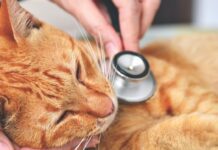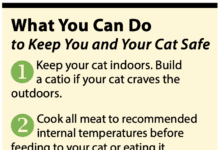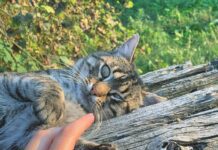Blood can be the gift of life not just for us, but also for our cats. “A cat suffering severe injury or trauma may require blood transfusions,” says Marjory Brooks, DVM, associate director of the coagulation section at Cornell Universitys Animal Health Diagnostic 288 Laboratory. Other indications for transfusion include surgical complications and anemia caused by autoimmune disease, renal failure, chemotherapy, parasites in the intestinal tract or fleas. “Young kittens are especially at risk for blood-loss anemia caused by flea infestation,” says Dr. Brooks. Cats that need plasma proteins to combat liver disease, clotting problems or rat poisoning may also require a transfusion. Qualified Donors. Just like human donors, feline donors are required to take a battery of tests prior to giving blood – and not every cat qualifies. One qualification is weight: A donor cat usually weighs from 10 to 12 pounds. “The bigger the cat, the less risk of hypotension (low blood pressure) after donation,” says Dr. Brooks. Cats are screened before they enter a donor program to ensure that they are free of viral diseases such as feline leukemia and feline immunodeficiency virus, and other blood-borne infectious agents such as Hemobartonella or Bartonella. “Before each donation, cats temperatures are checked, and they are given a physical exam to make sure theyre healthy,” says Dr. Brooks. Donors should be indoor cats that are maintained on a flea-control product and free of intestinal parasites. “Males tend to have a higher red-cell count and heavier body weight,” says Dr. Brooks, so male cats tend to make better donors than females. Donor cats are usually two to 10 years old, with no history of pregnancy or prior transfusion because of possible sensitization to foreign blood cells or proteins. Youre My Type. The vast majority of cats are type A. Type B is less common and type-AB cats (having red cells carrying both antigens) are extremely rare. Type O does not exist among the feline population, and there is no Rh factor as there is in the human population. Using a donor that is the same breed as a recipient is no guarantee that the blood types will match. “Theres a different proportion of types in different breeds,” says Dr. Brooks. (Approximately half of British Shorthair and Rex cats are type B while most domestic shorthairs are type A, for example.) Giving a recipient the wrong blood type can have dire consequences. “Giving type-A blood to a type-B recipient causes acute transfusion reactions,” says Dr. Brooks. “It could be fatal.” Another complication of blood type incompatibility is neonatal hemolysis (also called neonatal isoerythrolysis), a condition occurring when a type-B queen is bred to a type-A tom. Type-A kittens in the litter are at risk for anemia because their type A cells are destroyed by antibodies present in the queens first milk. For this reason, type-B queens should only be bred to type-B toms. The Process. The procedure takes five to ten minutes, during which time about 50 to 60 milliliters (about four tablespoons) of blood are taken. Cats must be heavily sedated or anesthetized while giving blood so they remain still. “Most cats arent patient enough,” says Dr. Brooks. Sometimes the donor is given fluids to combat hypotension. Cats should give blood no more than three to four times a year. “If a cat donates too frequently, she can become anemic or iron deficient,” says Dr. Brooks. Otherwise, giving blood has few risks. “A cat might have an adverse reaction to the drug used for sedation,” says Dr. Brooks, “or she might develop hypotension or a bruise or swelling at the blood collection site.” Some veterinary facilities maintain onsite donor cats or use blood from commercial animal blood banks. Clinics use various incentives such as health exams, vaccinations, free blood typing and transfusion if ever needed, and recognition for giving the “gift of life” to cats in critical need to entice cat owners to allow their cats to donate blood. At Cornell University Hospital for Animals, blood for patients comes from volunteer donors owned by staff or students.



